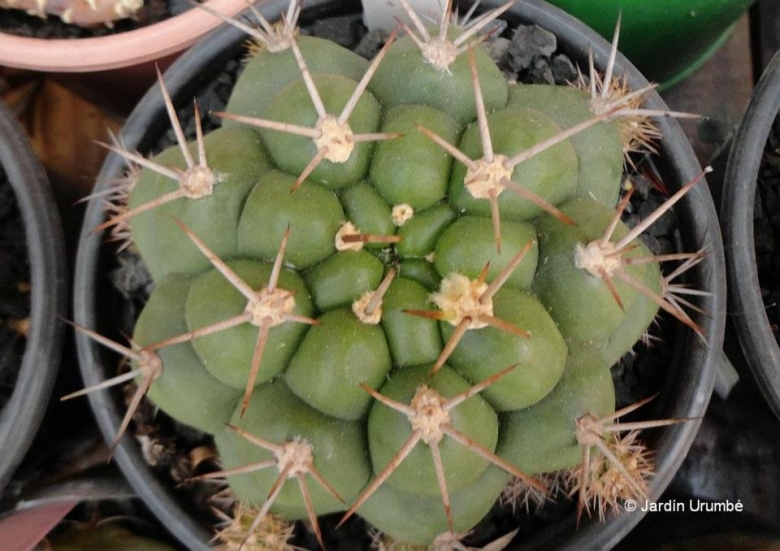= Gymnocalycium chiquitanum var. hammerschmidii (Backeb.) H.Till
Gymnocalycium 21(Sonderausgabe): 816. 2008 [Nov 2008]
Accepted Scientific Name: Gymnocalycium chiquitanum Cárdenas
Cactus (Paris) 78: 95 1963.

Gymnocalycium hammerschmidii (Gymnocalycium chiquitanum var. hammerschmidii) Photo by: Alexander Arzberger
Origin and Habitat: Province Chiquitos, department Santa Cruz, south of San Jose, Bolivia.
Synonyms:
See all synonyms of Gymnocalycium chiquitanum
Description: Gymnocalycium hammerschmidiiSN|26064]]SN|26066]] is at most a race of Gymnocalycium chiquitanum. The key difference by which the two were separated, namely the larger stems (up to 15 cm Ø) in Gymnocalycium hammerschmidiiSN|26064]]SN|26066]] seems entirely spurious suggesting that there is not really a fundamental difference between the two. More likely they are one and the same species and most authors have dismissed Gymnocalycium hammerschmidiiSN|26066]]SN|26066]] as perhaps not worthy of even varietal status.
Taxonomy note: Gymnocalycium hammerschmidiiSN|26066]]SN|26066]] was firstly collected in December 1961 by the Justinian Father Lorenzo Hammerschmidt. Some plants of the newly found species were sent to Prof. M.Cárdenas in Cochabamba and described as Gymnocalycium chiquitanumSN|26066]]SN|26064]] “Cactus” Nr. 78, October 1963 (Typus Nr. 5.562 deposited in Herbarium Cardenasianum). At the same time some plants were sent to the Ühlig company in Germany. There the plants were recognized by C. Backeberg as an obviously new species and described by him under the name Gymnocalycium hammerschmidtii (Descr. Cact. Nov. 3: 7. 1963). Because this description was published in December 1963 the name G. chiquitanum published by Cardenas has the priority. Nevertheless Backeberg in his "kaktus lexicon" indicated these two species as interrelated. In addition to the description, Father Hammerschmidt reported that adult specimens can reach a diameter of up to 15 cm.
Name disambiguation: There is some confusion over the correct spelling of G. hammerschmidii, helped by Backeberg misspelling Father Hammerschmid's name with a "t" in the Lexicon ( hammerschmidtii ), though he spelt it correctly when he named the plant.
For more details see: Gymnocalycium chiquitanumSN|26066]]SN|26064]].
Subspecies, varieties, forms and cultivars of plants belonging to the Gymnocalycium chiquitanum group
Bibliography: Major references and further lectures
1) Curt Backeberg “Cactus Lexicon” Sterling Publishing Company, Incorporated, 1978E.
2) Curt Backeberg “Descriptiones Cactearum Novarum” III 1963
3) W. Putnam. “Comments from E.W. Putnam.” The Chileans Vol. 1, No 6, p 15, June 1967 U. K . Edition
4) Hans Krainz “Die Kakteen” 1968
Cultivation and Propagation: Gymnocalycium hammerschmidiiSN|26066]]SN|26066]] is an easy to grow succulent, more cold tolerant than most and less fussy regarding soil conditions.
Growth rate: It is a relatively rapidly growing and easily flowering species that will make clumps given the best conditions.
Soils: It likes very porous standard cactus mix soil.
Repotting: Use pot with good drainage.
Watering: Water regularly in summer, but do not overwater (Rot prone), keep dry in winter.
Fertilization: Feed with a high potassium fertilizer in summer.
Hardiness: Reputedly somewhat resistant to frost if kept on the dry side prior to, and during, cold weather (hardy to -12 C ° C, or less for short periods).
Exposition: Outside bright but filtered sunlight or afternoon shade, inside it needs bright light, and some direct sun. Tends to bronze in strong light, which encourages flowering and heavy spine production.
Uses: It is an excellent plant for container growing. It always looks good and stays small. It look fine in a cold greenhouse and frame or outdoor in a rockery.
Pests & diseases: It may be attractive to a variety of insects, but plants in good condition should be nearly pest-free, particularly if they are grown in a mineral potting-mix, with good exposure and ventilation. Nonetheless, there are several pests to watch for:
- Red spiders: Red spiders may be effectively rubbed up by watering the plants from above.
- Mealy bugs: Mealy bugs occasionally develop aerial into the new growth among the wool with disfiguring results, but the worst types develop underground on the roots and are invisible except by their effects.
- Sciara Flies: Sciara flies are one of the major problems for seedlings. It is a good practice to mulch your seedlings with a layer of grit, which will strongly discourage the flies.
- Scales: Scales are rarely a problem.
- Rot: Rot it is only a minor problem with cacti if the plants are watered and “aired” correctly. If they are not, fungicides won't help all that much.
Propagation: Division, direct sow after last frost. Seeds germinate in 7-14 days at 21-27° C in spring, remove gradually the glass cover as soon the plants will be well rooted (ca 1-2 weeks) and keep ventilated, no full sun for young plants! To make a cutting twist off a branch and permit it to dry out a couple of weeks, lay it on the soil and insert the stem end partially into the soil. Try to keep the cutting somewhat upright so that the roots are able to grow downward.











